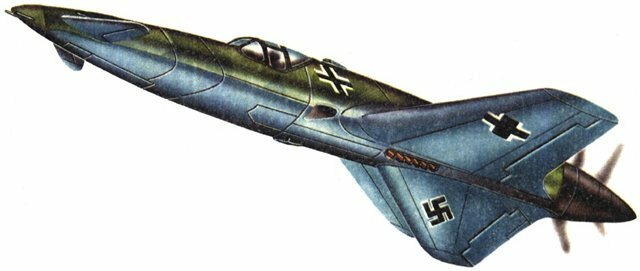Henschel Hs Project 75

The project is still today the actual scheme of a combat aircraft, which in the pre-war years served as a pretext for intense controversy in various countries. Some samples of such aircraft underwent flight tests before 1945 (for example, the Italian SA / SS64, the American Curtiss XP-55 "Askerder" or the Japanese Kayusi J7W1 "Sinden"), but they were distributed for the first time only using our days
Along with the aerodynamic features, the concept of the Henschel company made it possible to place heavy rifle armament in the forward fuselage, whose considerable dimensions and assembly technology turned out to be ideal for a wide and heavy power plant consisting of twin DB 603 engines. Keel vertical tail protects the screws from touching the ground.
Propulsion unit: 1 x Daimler Benz DB 613A/B, 24-cylinder twin engine liquid-cooled take-off power 3500 hp with two coaxial screws with a diameter of 3,2 m driven by a long shaft
Sizes (partially reconstructed)
Wingspan: 11300 mm, sweep: 16° along the 1/4 chord line (from the nose of the profile)
Wing area: 28,4 m2, aspect ratio: 4,5
Full length: 12200 mm
Maximum height: 4300 mm
Weights
Takeoff weight (approx): 7200 - 7500 kg
flight data
Maximum speed: 790 km/h at an altitude of 7 km
Service ceiling: 12000 m
Military equipment
Armament: 4 x MK108 caliber 30 mm in the forward fuselage
Experiments with a model in a wind tunnel led to pretty good results. The project has reached a stage where it is possible to immediately begin the development of design and technological documentation. But this is not the case. Despite the support of the technical services, the Luftwaffe rejected the project on the grounds that “the pilots will not be able to get used to the fact that the propeller is in front of or behind the tail”.
Flight tests had, of course, to clarify whether the expected increase in flight characteristics of such a heavy “Ente” would correspond to its use as a fighter, especially in cornering battles.
Information